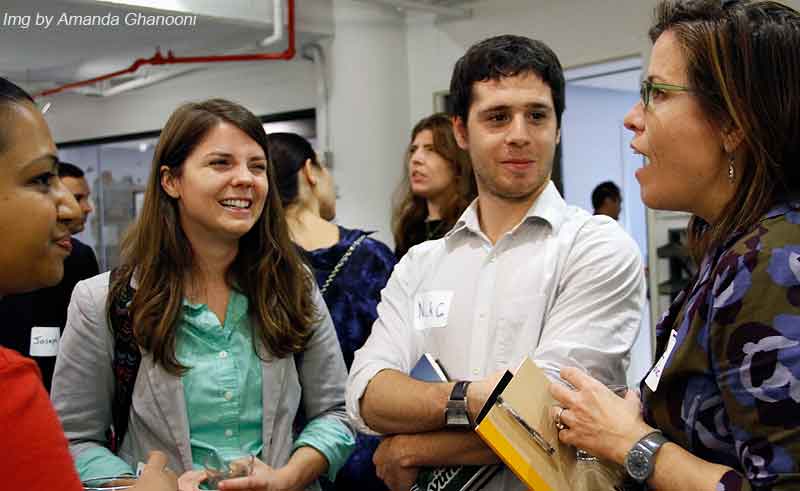Author Porter Gale may have spelled it out most clearly: Your Network is Your Net Worth.
If you could isolate only one single factor to determine career success, from landing your very first position to advancing up the corporate ladder and even helping when things aren’t going well, it’s having a solid network in place.
Networking is about making connections and building enduring, mutually beneficial relationships. It’s a vitally important skill, yet one that still mystifies many people.
Let’s take a look at 5 networking tips from industry experts:
1. Change form a “Guest†to “Host†mentality
We all know that it can be a challenge when meeting new people, and when we do we tend to fall under two categories. Dr. Adele Scheele, author of Skills for Success, says that people in a networking event tend to behave as either “hosts” or as “guests.”
Hosts exhibit gracious manners and go out of their way to meet people they don’t know, start conversations, introduce others, and generally be the friendly connector at an event.
Guests, however, might act in the exact opposite way. They wait for someone else to take their coats, offer them a drink, and introduce them around the room. Dr. Scheele suggests that the key is to moving from guest behavior to host behavior.
So next time you’re in a networking situation, shift to a host mentality as a way to be better remembered.
2. Remember their name
While some people claim they “never forget a face,†I think the majority of people have a problem remembering names of people they just met.
Benjamin Levy, the author of Remember Every Name Every Time, advocates a framework called the FACE method: Focus, Ask, Comment, Employ.
Here’s how it works:
- First, you must Focus: Lock in on the person’s face
- Then you Ask: Inquire which name they prefer (“Is it Dave or David?â€)
- Next, you should Comment: Say something about the name and cross-reference it in your head (“My brother’s best friend’s name was Daveâ€)
- Lastly, Employ: Put the name to use to drive it home (“Nice seeing you, Daveâ€)
3. Work on your body language
According to body language expert Vanessa Van Edwards of ScienceOfPeople.com, one of many body language techniques is to point your feet towards the other person you are speaking with, which is an easy way to show that you are engaged in the conversation.
This might not seem like much, but our brain actually registers the feet subconsciously, and it also has the added benefit of forcing us to point our torso and head towards someone. This is a nonverbal way of telling someone you are interested and connected.
4. Continue the conversation
Many people are comfortable starting a conversation, but have trouble continuing it. This can often lead to the dreaded awkward silence as you think about what to say next and keep the other person engaged.
Public speaker and communication consultant Dan O’Connor suggests using the following phrase next time the person you’re speaking with offers up a pause in the conversation:
“That’s interesting. Tell me more.”
This amazingly simple line can be used to continue the conversation, and makes the other person want to continue speaking because you’re interested in what they were saying.
Rather than being the person that always needs to get the next line in, this allows others the chance to speak about what they think, feel or love to do, building rapport.
5. End the conversation politely
Starting up a conversation is one thing, getting out is another. What do you do when you find yourself trapped in a dialogue that you want to get out of, without hurting the other person’s feelings?
According to How To Work A Room by Susan Roane, she advises to say, “It was nice to meet you, Sam. I don’t want to take much more of your time, especially because there might be others who want to speak with you too.”
Another option to end the conversation could be, “Hey Dylan, I’m so glad we talked. You gave me some interesting ideas to think about.†Including the name of the person makes it just a little more personal and helps to signal that the end has come.
Or if all else fails, use the old stand-by: Politely excuse yourself to refill your drink, grab another snack, or use the restroom. Just be sure to follow through… saying that you really need to use the bathroom and then heading straight over to a more popular group of people to join their conversation could backfire some day.
Conclusion
Whether you’re actively looking for a job or not, networking gives you the chance to socialize and connect with others. Sometimes people will be in the same industry and have the same goals as you, but often times it’s people outside your core network that can help you the most.
Whether you like it or not, each time you meet someone, you’re marketing your business and yourself. Effective networking is all about finding mutual benefits, but always start by determining how you can offer a service or help someone else. Give first, don’t ask.
Now if you’ll excuse me, dear reader, unfortunately my glass is empty and I need to go grab a refill.
Note: This article was originally written by Aurus Sanchez, The Conversationalist, and first appeared in a post for Salary.com.



